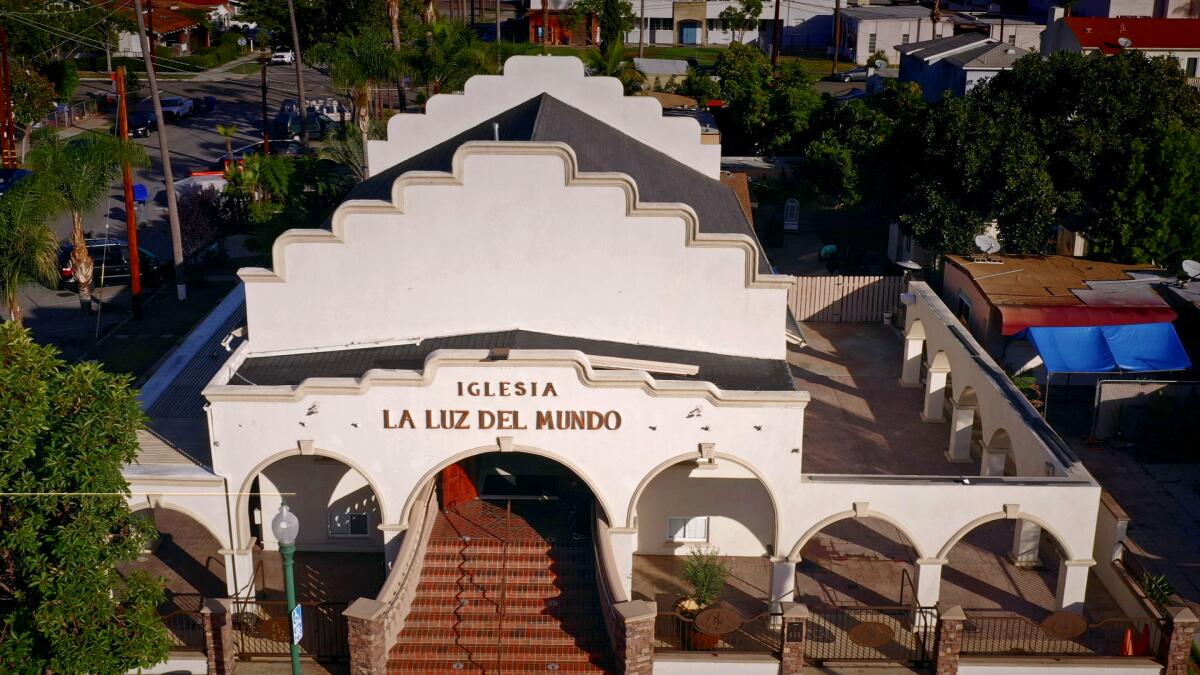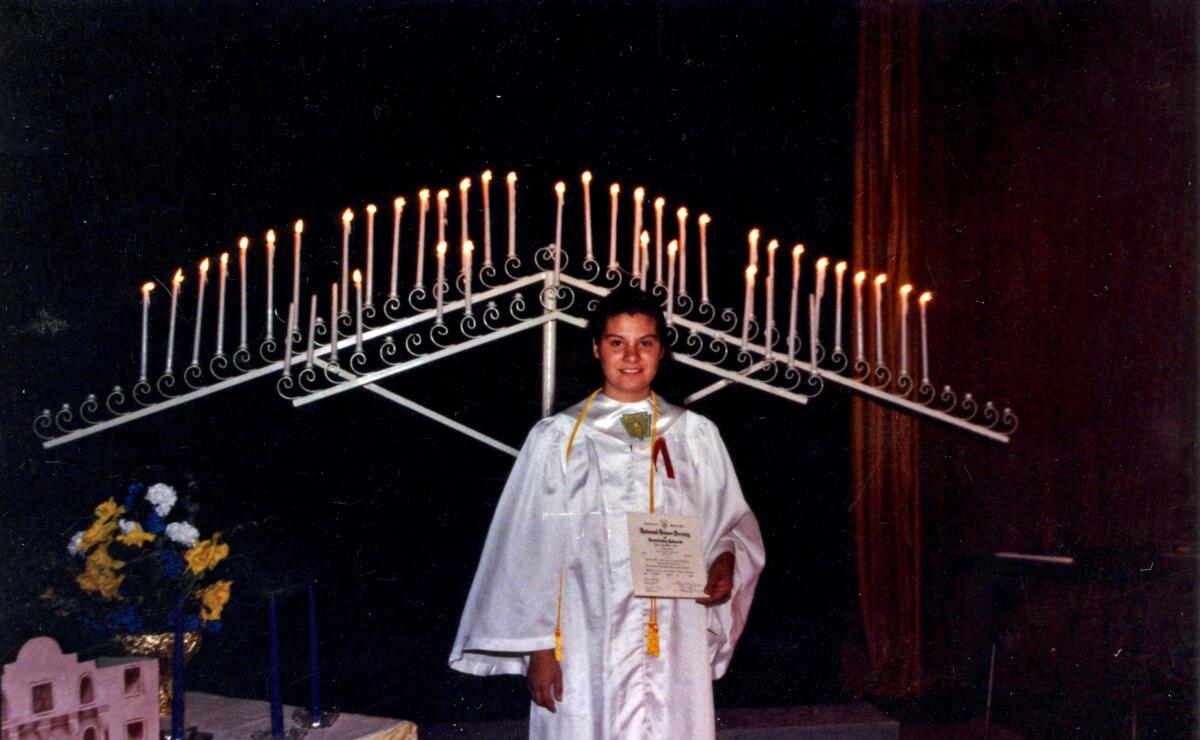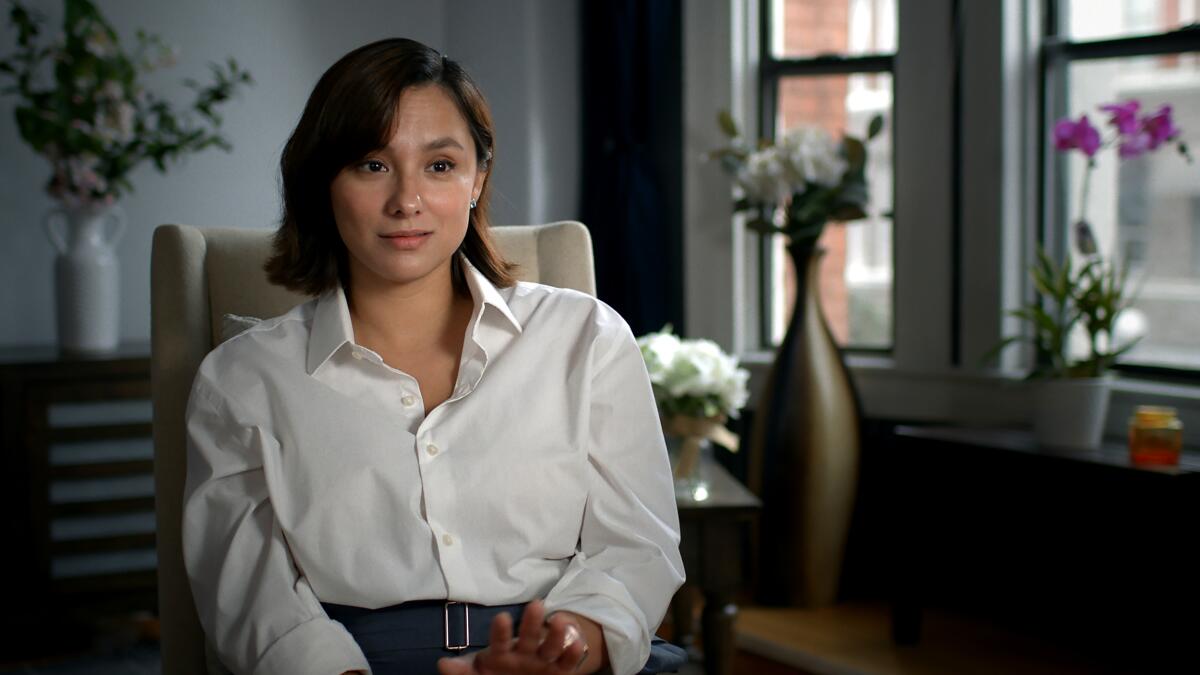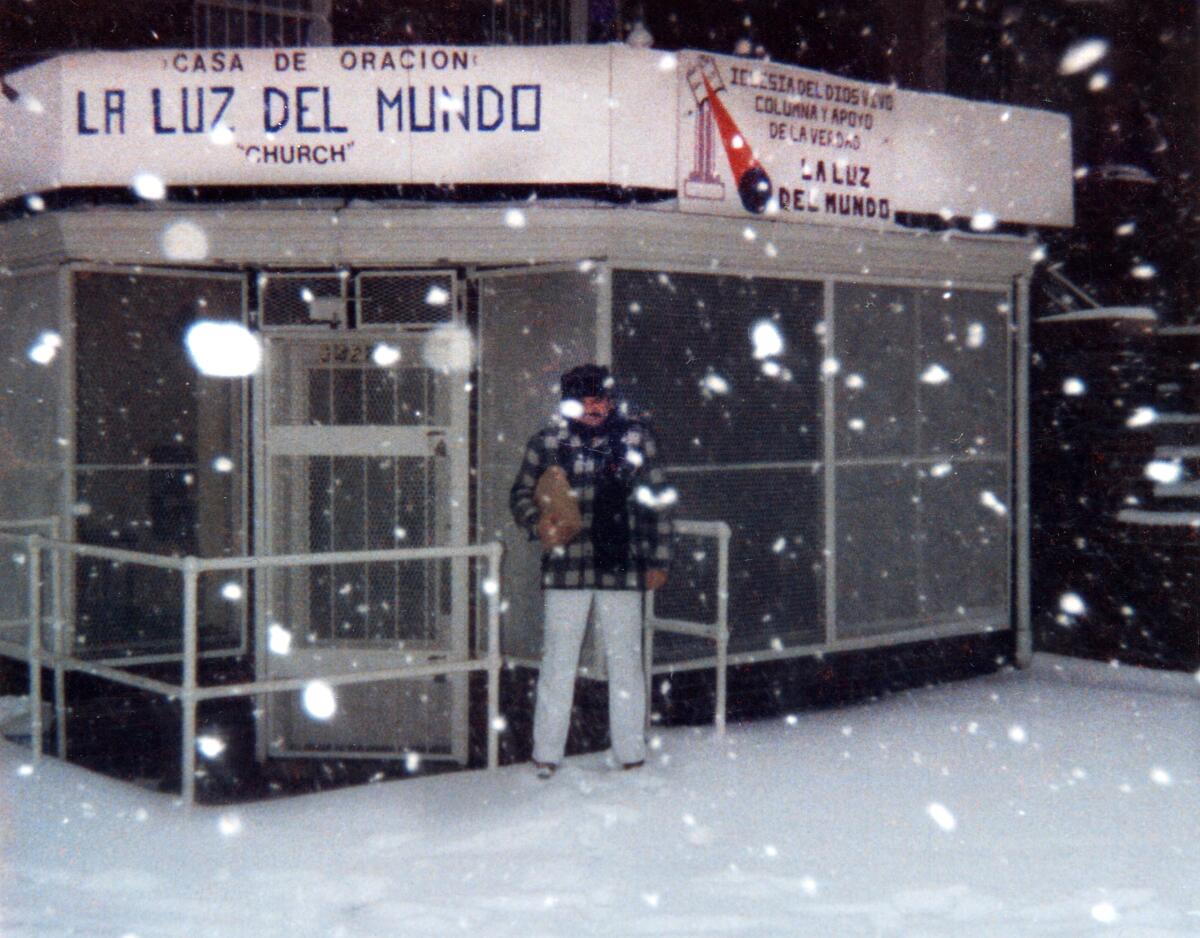A plea deal ‘buried’ the abuse at a Mexican megachurch. A new doc hopes to unearth it

If you live in Los Angeles, you’ve probably sped past La Luz del Mundo church, an ornate, 9,600-square foot outpost of the Mexico-based evangelical megachurch hard by the 60 Freeway in East Los Angeles. Founded in 1926, the Christian denomination claims to have more than 5 million followers in approximately 50 countries — and yet it has remained relatively obscure to the general population, even as it has been plagued by accusations of sexual abuse.
L.A.-based filmmaker Jennifer Tiexiera was oblivious to it all too. But when she came across the reporting of longtime investigative partners Rhonda Schwartz and Brian Ross, which alleged that the church groomed members, mostly children, for the pleasure of its leaders, Tiexiera wanted to draw more attention to the story.
“In the almost two years that I’ve been working on it, I am constantly finding myself just trying to explain to people what it is,” says Tiexiera, whose other credits include the 2020 LGBTQ documentary “P.S. Burn This Letter Please.” “Meanwhile, I’m sitting in my home in Los Angeles, and I’m surrounded by four of [the churches] within a 10-mile radius. I see it all the time.”
“Unveiled: Surviving La Luz del Mundo,” premiering Tuesday on HBO, is a three-part docuseries exploring the history and power of the church (which translates to “The Light of the World”), whose congregants believe its leader is an “apostle” appointed by God, to whom they must show unwavering loyalty and obedience. And it’s against this backdrop that former members detail the years of abuse they say they endured.
Naasón Joaquín García, the current leader of La Luz del Mundo and the grandson of its founder, was arrested in 2019 on suspicion of human trafficking, production of child pornography, forcible rape of a minor and other felonies. In June, García pleaded guilty to three counts of sexual abuse of underage girls in exchange for a reduced prison sentence of nearly 17 years — a plea bargain that enraged the survivors who came forward.
Tiexiera spoke with The Times about the series, aligning the needs of trauma survivors with the demands of documentary storytelling, and capturing the mind-set of someone whose faith has been weaponized.

What drew you to the story of La Luz del Mundo?
After I picked my mouth up off the floor, I did have that feeling of frustration and anger, which I always know is going to be probably a good project for me. And the fact that there was so little coverage and the fact that the arrest was happening at the same time as the [Jeffrey] Epstein case and the NXIVM case, yet we weren’t hearing about this, even though [García] was arrested and had $90-million bail in downtown Los Angeles. I’m just like, “Why are we only covering certain stories?” When I put my pitch forward to Jigsaw [Alex Gibney’s production company] and HBO, I said I would tell the story, but I needed it to be completely survivor-driven. I needed them to have complete agency. I needed the room to do that: to make sure that I had time to really nurture those relationships before a camera was even brought into the room, that we had the same intention of the story, that we wanted the same things from the series, that we had a team in place of mental health experts, psychologists, psychiatrists, a trauma center to kind of help us dissect the process. And with those things come costs — that affects the bottom line. Like, there were certain interviews that I knew I was going to have to shoot both ways, anonymously [and] not anonymously, and still then give the participants the option to pull out if they wanted to, which ended up ultimately happening. And, you know, because this is the first time some of these survivors have spoken out, after coming out of a lifetime of coercion and dishonesty and control, it was just really important that we weren’t doing anything to re-traumatize or cause any more pain. And so that was a promise in the beginning: nothing that would put their physical self in danger, their mental health in danger, or their potential court cases.
One of your recent films, “Subject,” examined ethics in the documentary genre, exploring questions about what happens next for a film subject after the cameras stop rolling and what it does to a person to have their lives examined in such detail. How did that inform your approach with this docuseries and how you thought about your subjects?
I don’t think I would have taken on this project if I hadn’t just spent five years making “Subject.” I knew there were a lot of hard conversations I had to have right in the beginning to make sure that the transparency was very clear of what they were putting at risk and at stake by participating. They might trust me with this and relive it, and there were certain things that were going to be out of my control when there’s a network involved; they might not be in it. These are conversations that are really tough to have but pay off in strides later.
Since the #MeToo movement really gained attention, Hollywood has been interested in documentaries about sexual abuse, and there’s been this debate about whether the demands or needs of a documentary narrative align with the needs of the survivors who are still processing the trauma. How did you navigate that push and pull?
I think one thing that was really, really, really important was [the subjects] having the option, regardless of a release — that dumb piece of paper — to pull out if they needed to pull out. They had the dates when my control was gone. They knew if there was any sort of doubt, they could pull out. And we had survivors pull out. We called it “the consent calendar.” So there were these check-in points and what could happen — like, this was the last day that they could decide whether or not they want to be in it anonymously or not anonymously, or how they wanted their names to appear. As we moved forward with it, they knew how, if we get deeper, it becomes harder, but they still have that option. We would do what we needed to do and take them out of the series.

What was your approach to covering a story that goes back so many decades and generations?
It’s very easy for outsiders to be like, “I would never let ...” or “That seems so obvious,” but I really wanted to make sure that somebody who’s not from a Latino background could understand what it means to feel responsible for your family’s and your own eternal salvation. And that was something that I do think our survivors were able to convey so well and so powerfully. “It was my mom. It was my dad. I was 14. I was 11. All I knew is I didn’t want these people who I love so much to burn in hell.” It adds another layer in these religious cults; it’s another way to control that’s just so mind-blowing to me — using something that’s so beautiful, the best part of humanity, that faith, and using it as a weapon to control.
Did you face any hurdles? Were you scared of taking on the church or ever fear for your safety, given the allegations of abusive tactics used with people who have left the church?
Absolutely, and still do ... It was pretty intimidating during the filming process, especially filming in Mexico. But now that it’s out in the world, you know, it’s unfortunate too because it’s like, I’ve met so many amazing, beautiful people who are part of this organization. It’s not the membership that’s wholly corrupt. It’s the hierarchy. And that breaks my heart.
There are many haunting moments that stay with you after watching. And one of them is the story that ex-member Leticia tells about finding her then-9-year-old sister, Keila, in a harmful situation with Samuel Joaquín Flores, García’s father, who preceded him as the so-called apostle. It’s so personal and so heartbreaking. What was it like to be around that kind of emotion?
Over the 100 years [of the church’s existence], there’s this repetition. It was the same story over and over. We were finding survivors, and it was like: “When Samuel was 60 ...,” “When Samuel was 50 ...,” “When Samuel was 40 ...,” or “When Naasón was 30 ...” That story was so eerily similar to the ones that other survivors were sharing with us. And so when you’re trying to put together something like this in 3 1/2 hours, you have to go into the story. And this was part of the story that a lot of survivors had experienced: the idea of family members suffering abuse to please the apostle. When they [Leticia and Keila] decided they wanted to share the story, it was a very, very powerful moment. I watched it with them together. After the interviews itself, I tend to come home and I’m in bed for a day or two. I usually did a session; we had amazing psychologists on the project to help us pick our feelings apart. And then watching it again was also very draining — sitting with them watching it again and asking, “Do you feel comfortable with this?”
Even with the trailer release — I sat and watched with all of the subjects and discussed it. That’s like 16, 17 people that we have to sit, watch it, take notes, talk through their concerns, everything. We didn’t show the entire series to everybody, because it’s just me. But everyone saw their parts in the entirety. And then we shared it in its entirety with the lawyers representing the Jane Does to make sure that even though they’re not part of this series, that they felt represented in the correct way.

Do you expect there to be more to this story? Naasón is serving his sentence, but he’s still addressing his followers by phone from prison. Are you interested in the aftermath?
Absolutely. I would be so devastated if this didn’t move forward or if this was the end. The whole hope is for a federal case getting started again, but also for other survivors to come forward if they wish to do so. There’s already been people who’ve gotten in touch with me being, like, “If this continues, I want to tell my story.” So first and foremost, we’re trying to make sure that the resources are there and can support the people who are coming forward and who need that support. We’ll see. There’s no plans right now for the series to continue.
At the end of the series, there’s the sobering statement from the five Jane Does about being subjected to harassment and intimidation. Saying that they’ve gained nothing from coming forward. After the trial, survivor and “Unveiled” subject Sochil Martin expressed concerns that other potential survivors won’t come forward because they think there is no justice, especially if you’re Latino. What has this case illuminated for you about that?
Living this for almost two years now, being constantly reminded every day of how broken the system is, that was pretty sobering. I tend to be a pretty happy person, so it sounds weird that I want to infuriate people and make them as angry as I was when I first found out about this case. The hope is that we make a lot of people angry. And by doing that we really create this army where there has to be something done. Something that the survivors said to me when this plea deal came out was that now this series is more important than ever. They still haven’t had their day in court. It’s hard to express what’s happened to you when people don’t even know what La Luz del Mundo is. And hopefully, where the California case kind of fell to the wayside and was able to be buried, with this kind of exposure, it won’t happen in a federal case.
Was there a story that didn’t make the cut that you found really fascinating?
One thing that blew my mind that I thought was very important, but we just didn’t have the time to get in there, was that Naasón, before he was arrested, decided to have his 50th birthday in the Palacio de Bellas Artes — that’s like, I don’t know, having [a religious leader’s] birthday at the White House or something. I can’t really find the equivalent, but it’s such a sacred place. And for me, that really signified how deep the ties with this church go in Mexico, and with the government. No wonder he thought he was untouchable.
Naasón was charged along with members Alondra Ocampo, Azalea Rangel Melendez and Susana Medina Oaxaca. And in the documentary, you get into the tangled web of abuse and grooming and how someone like Ocampo, who herself experienced abuse, could be involved in the perpetuation of it. How was it to capture that and give it the space it needed?
It was imperative. It’s not very much later in the series where you find out that Alondra was first raped when she was 8 years old. I have a daughter. It makes me sick to my stomach, the complications in this. It’s all so complicated. Alondra has done her time and has admitted her wrongdoing. I think she does deserve that from us, if you’re asking my personal opinion. And so it was extremely important to find a way to not make excuses, but to humanize these experiences and to really try to put ourselves in those positions, as crazy as that might sound.
I want to give you the space to talk more about the collaboration with Rhonda Schwartz and Brian Ross because I think, in this moment where there’s some media distrust, we lose sight of how important the press can be, the importance of investigative journalism and the value of putting the resources into newsrooms to uncover atrocities such as what happened here.
We’re coming out of this crazy period where the press has just been so vilified. And then you have a situation like this, where, again, not a lot of people were listening. And they made that decision to dig deeper. This could have been going on for another 100 years, a countless amount of children could still be being groomed as we speak, and nobody would know any different. That’s insane to me. If that’s not a reason enough, right there, then I don’t know what it is. But the collaboration with Rhonda and Brian — when you have people who are as seasoned as the two of them — I wouldn’t be here without it. I wouldn’t have been able to continue building on that trust, building on that quality reporting. When you’re on these quick turnaround television schedules, there’s no price you can put on it.
‘Unveiled: Surviving La Luz Del Mundo’
Where: HBO
When: Tuesday, 9 p.m. and 10 p.m., concludes Wednesday 10 p.m.
Rating: TV-MA (may be unsuitable for children under the age of 17)
Streaming: HBO Max, Any time, starting Tuesday
—
More to Read
The complete guide to home viewing
Get Screen Gab for everything about the TV shows and streaming movies everyone’s talking about.
You may occasionally receive promotional content from the Los Angeles Times.







